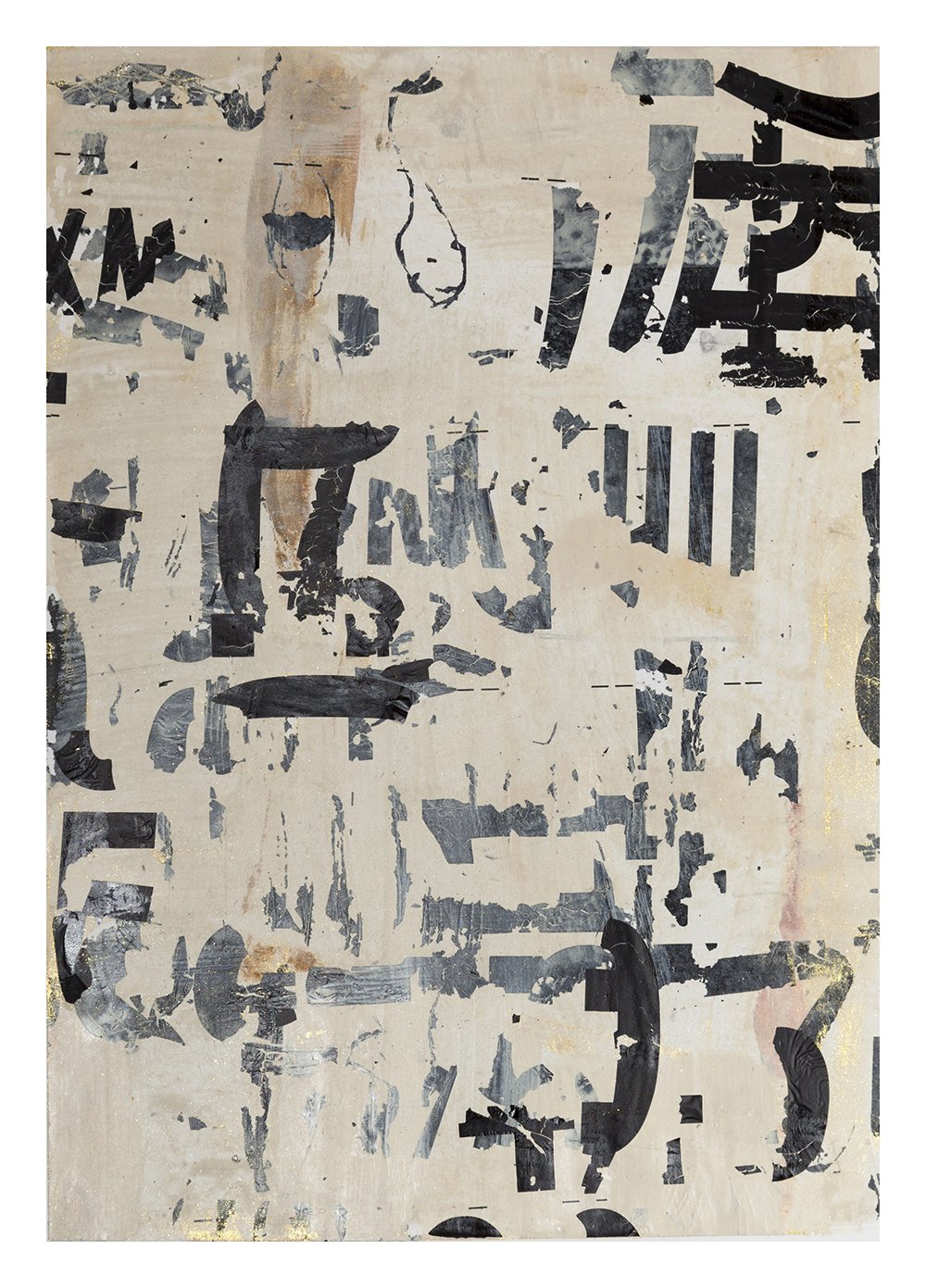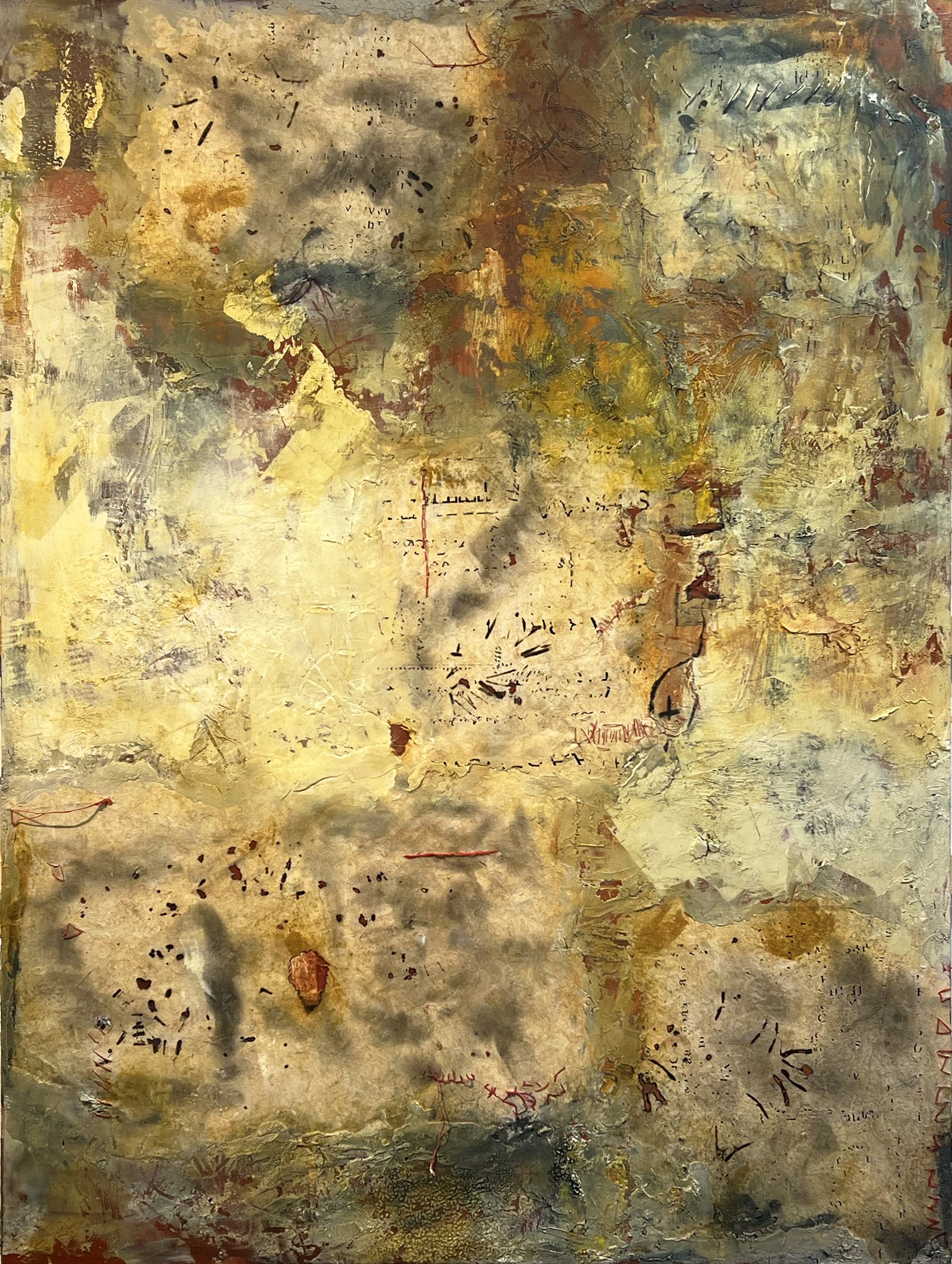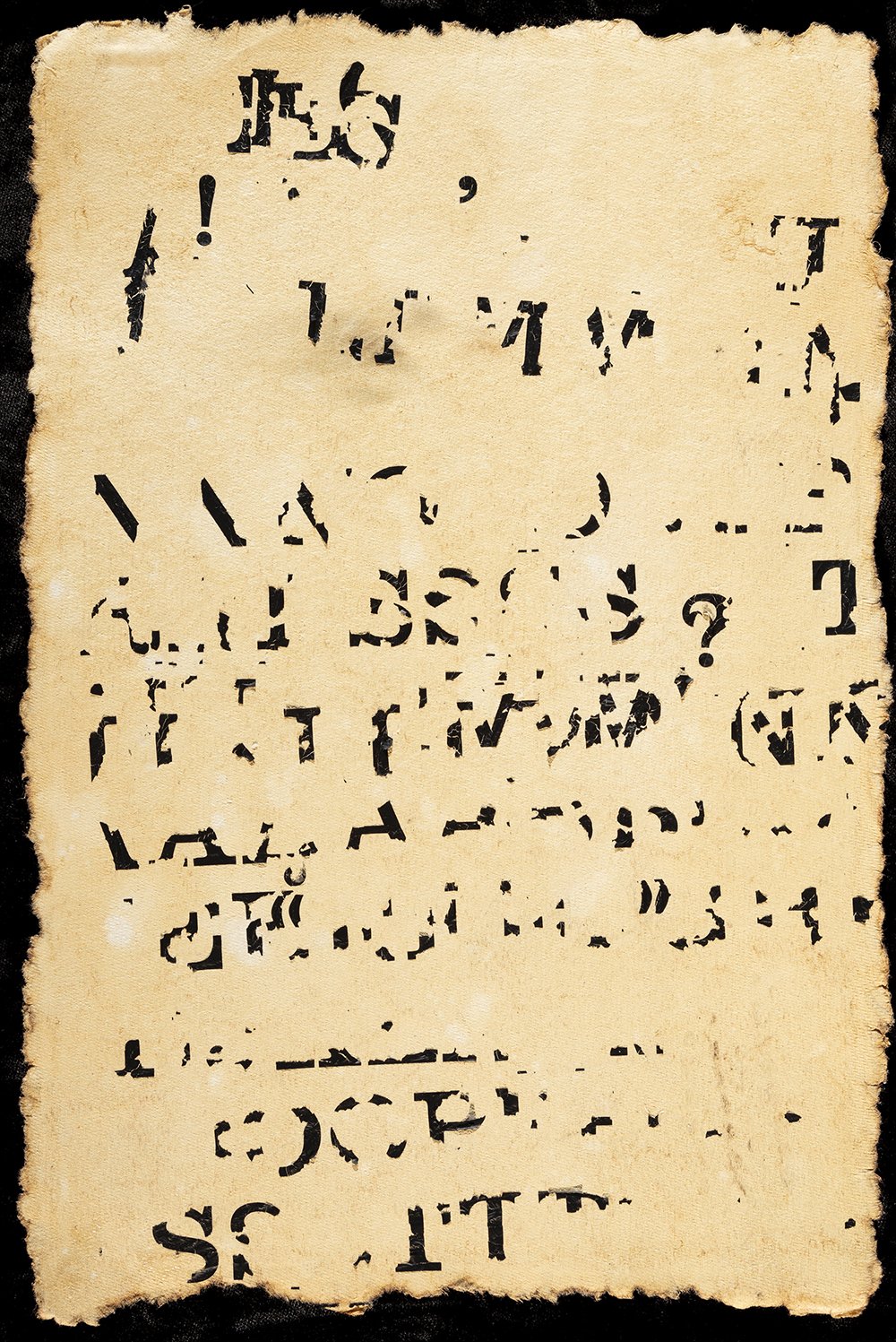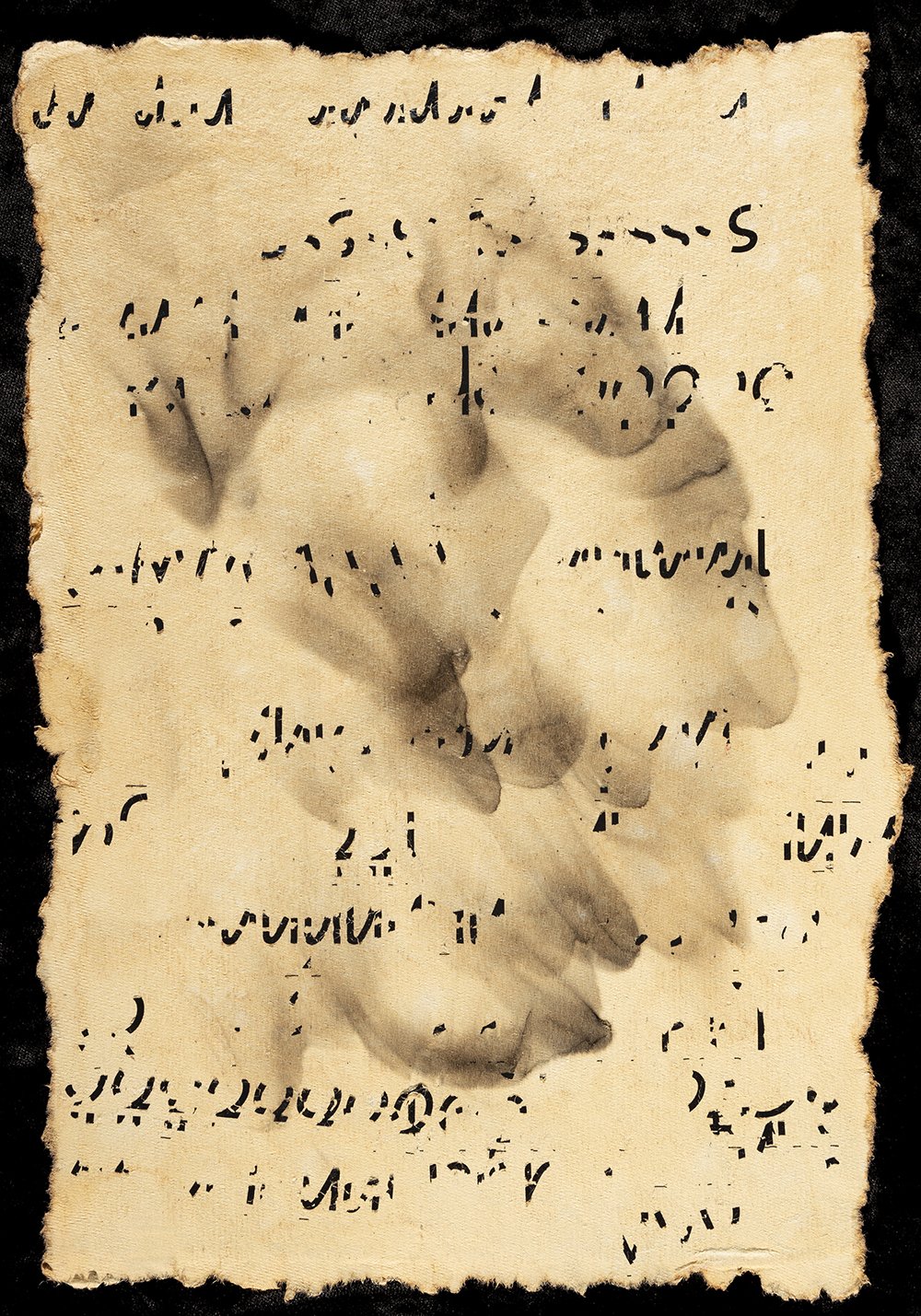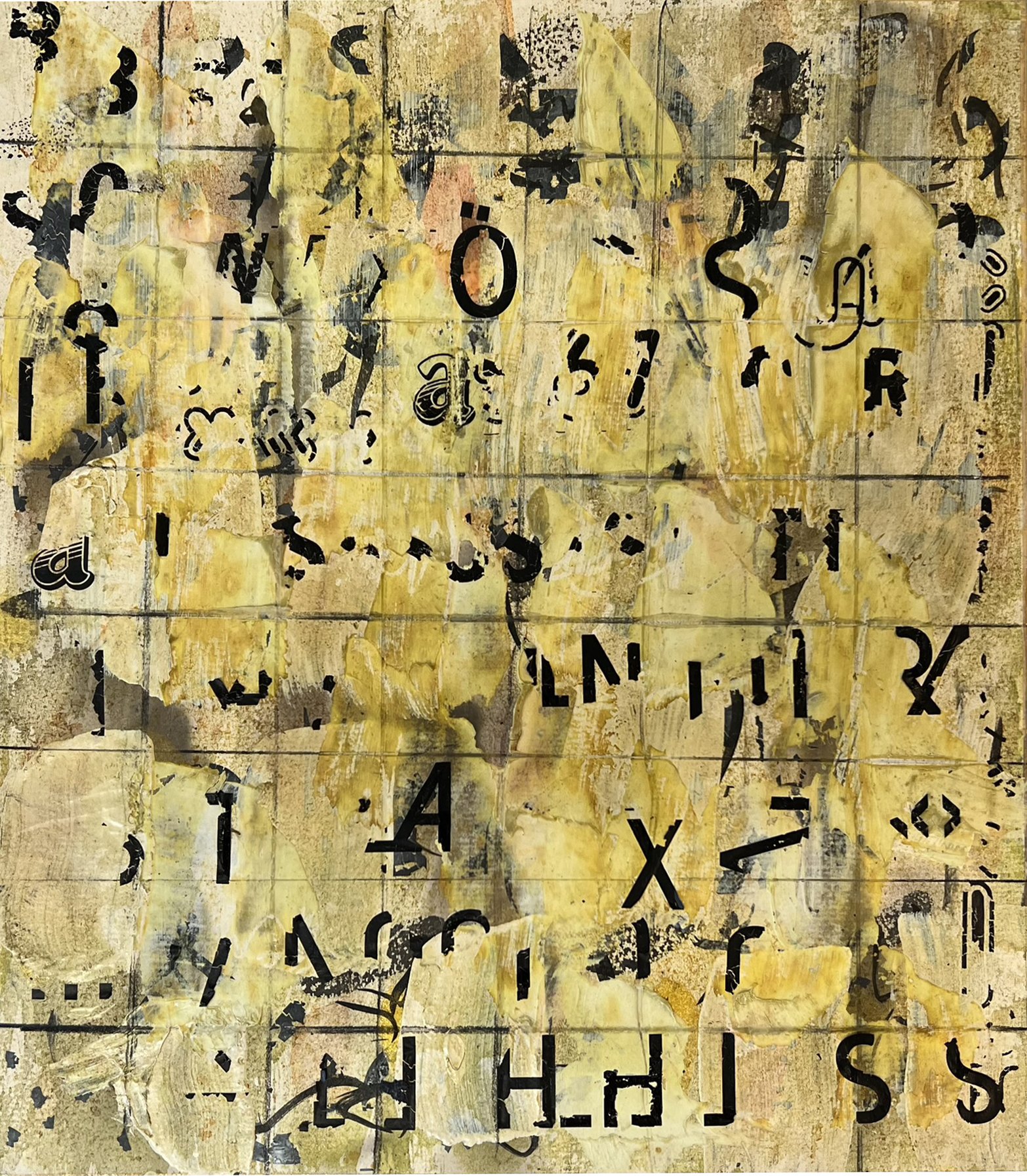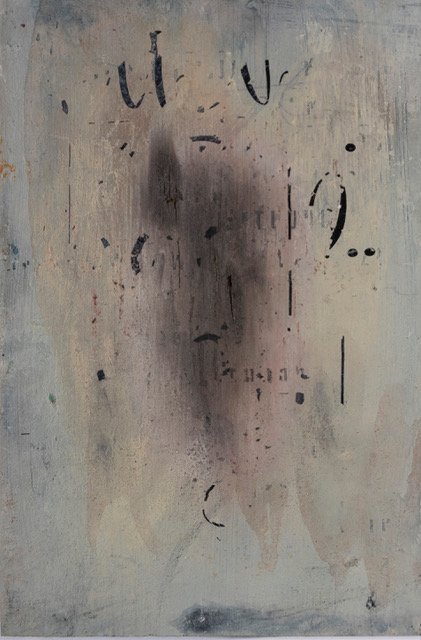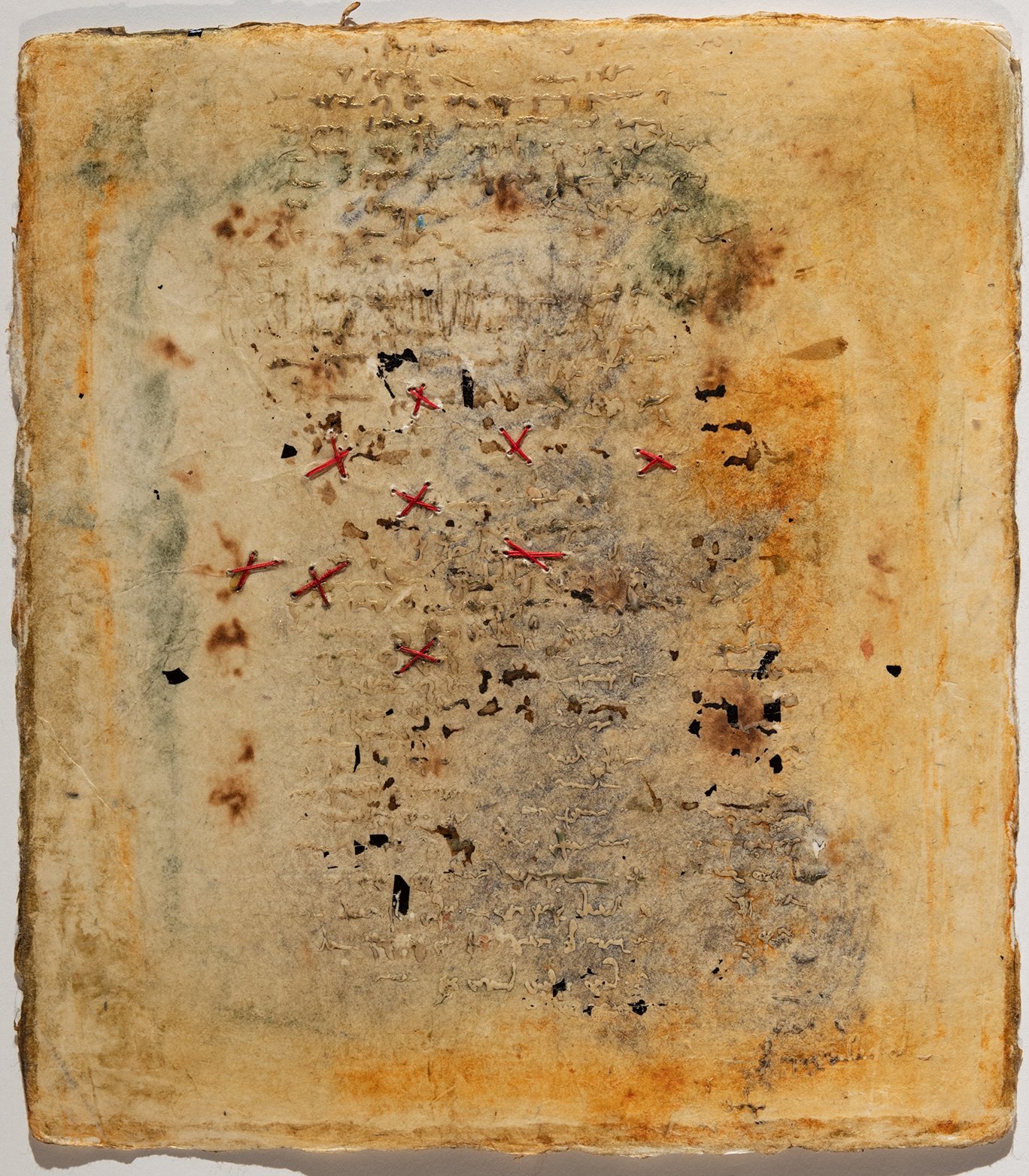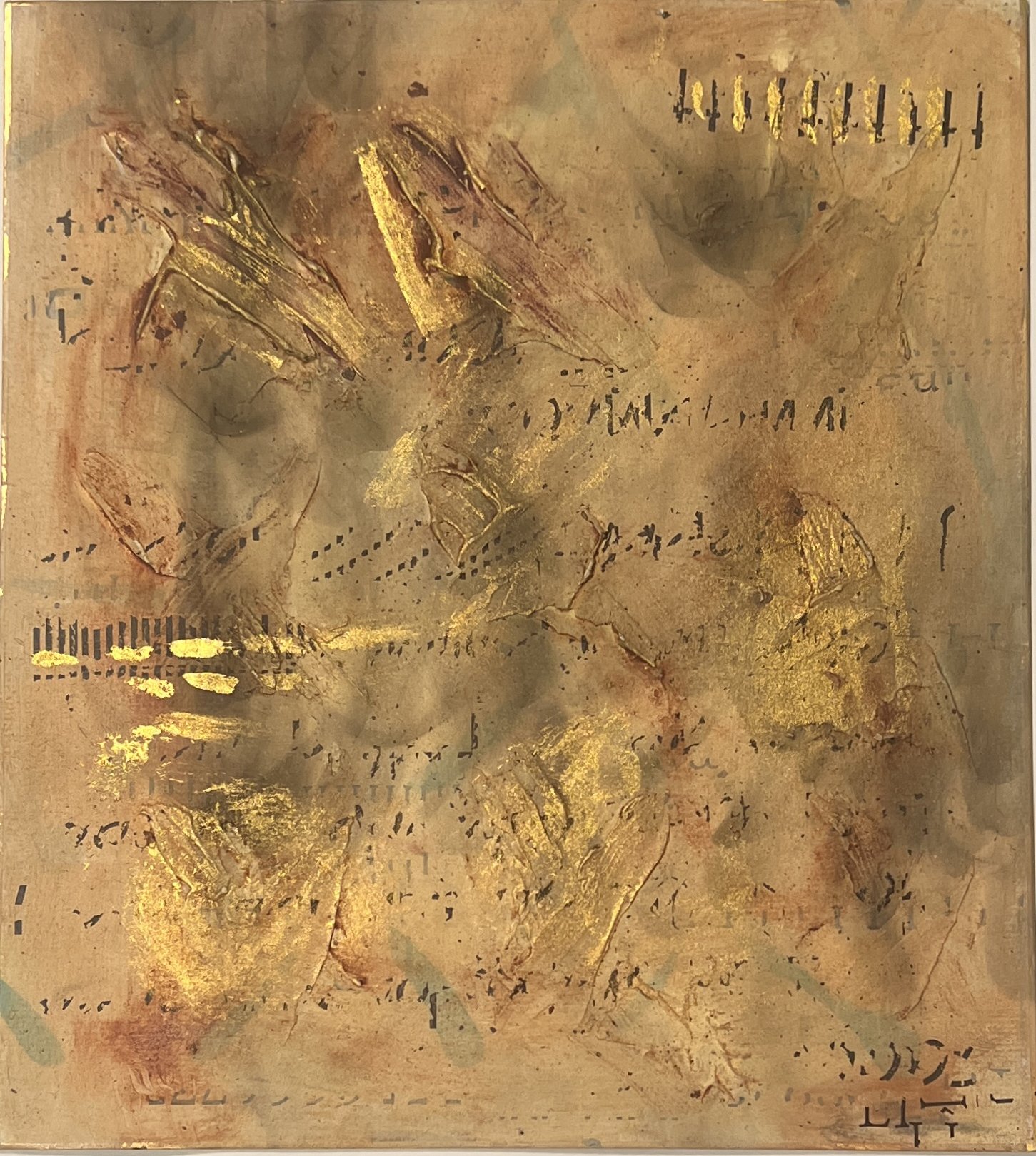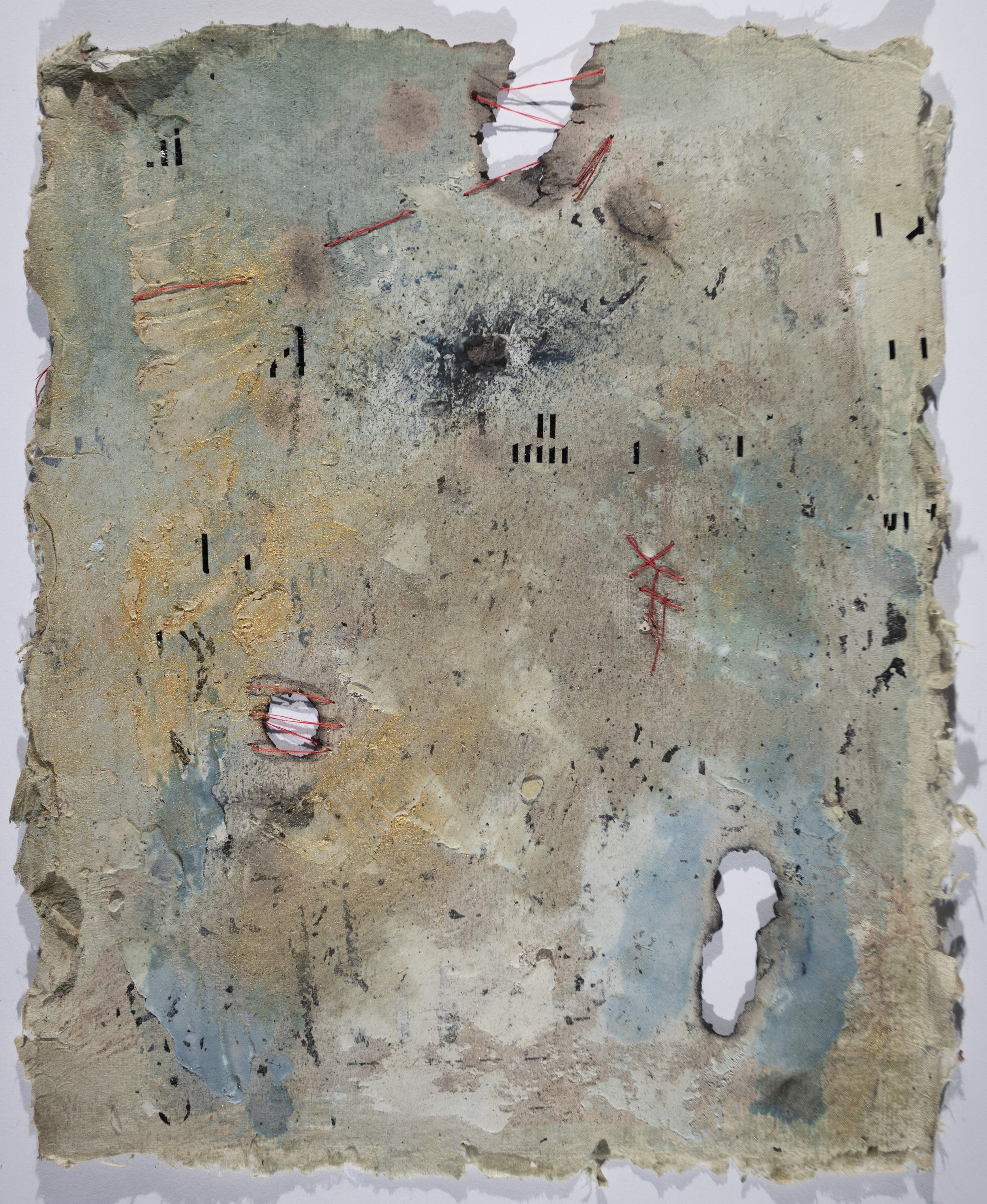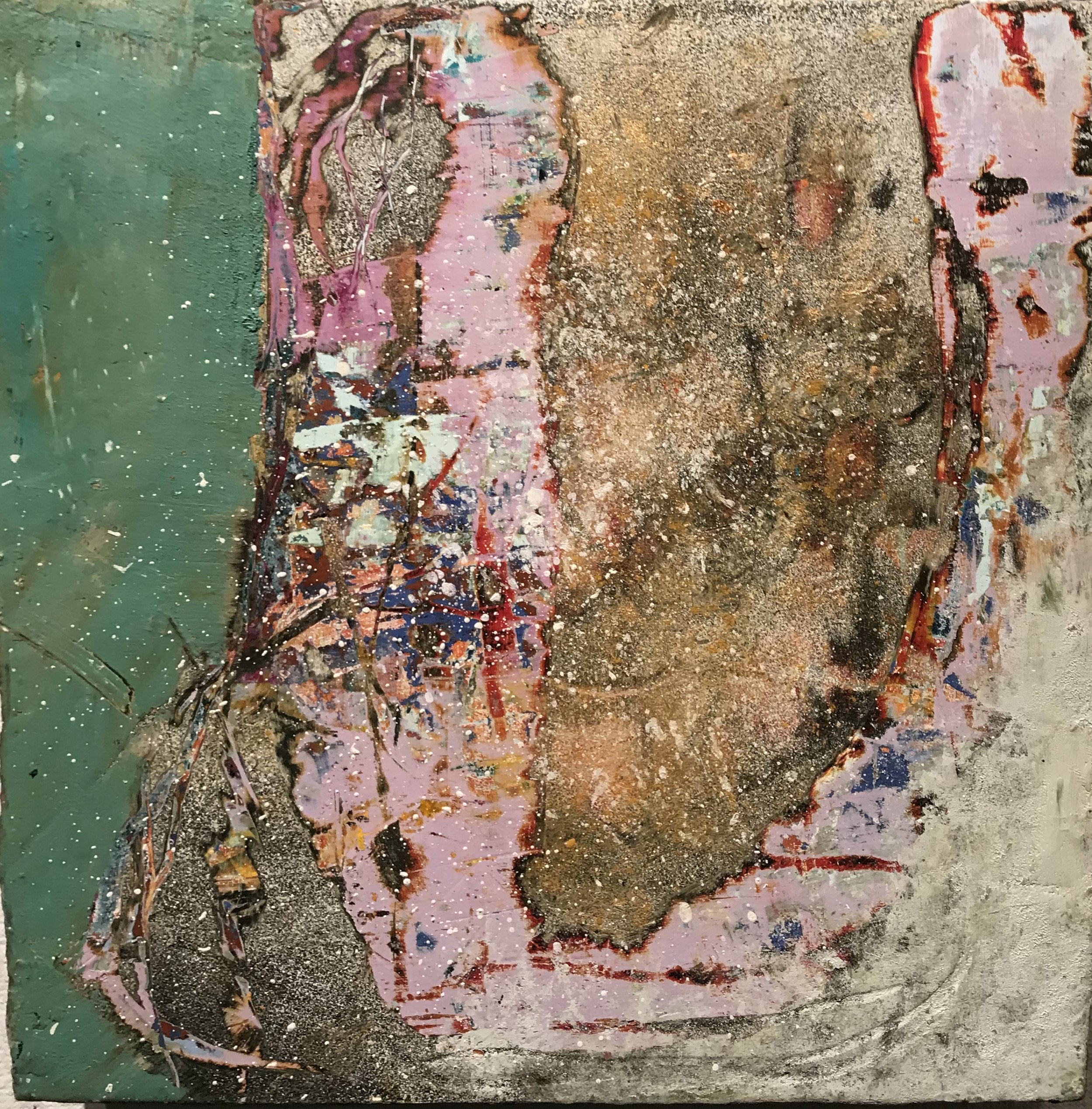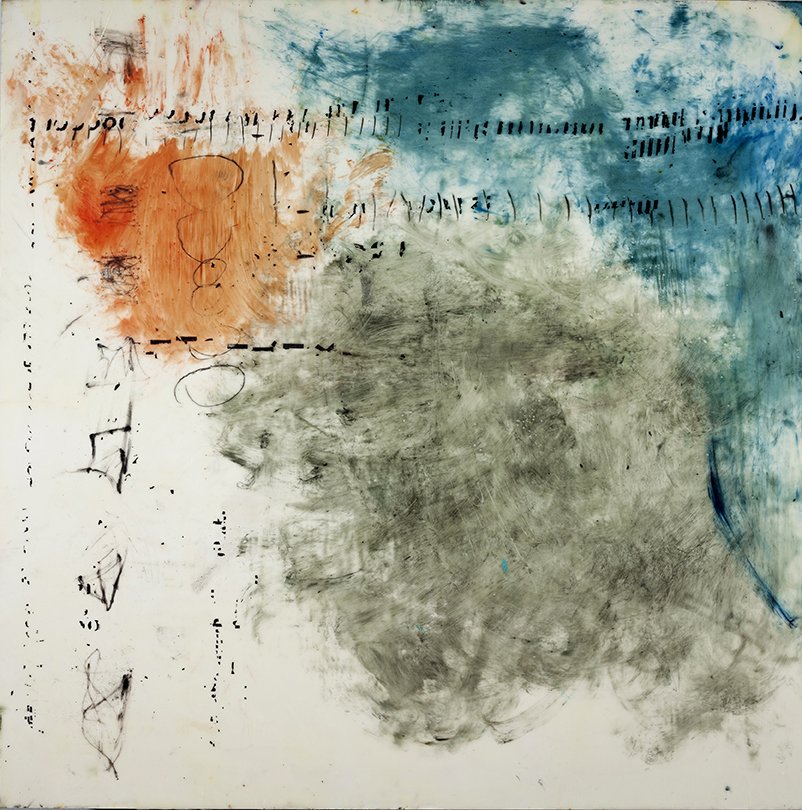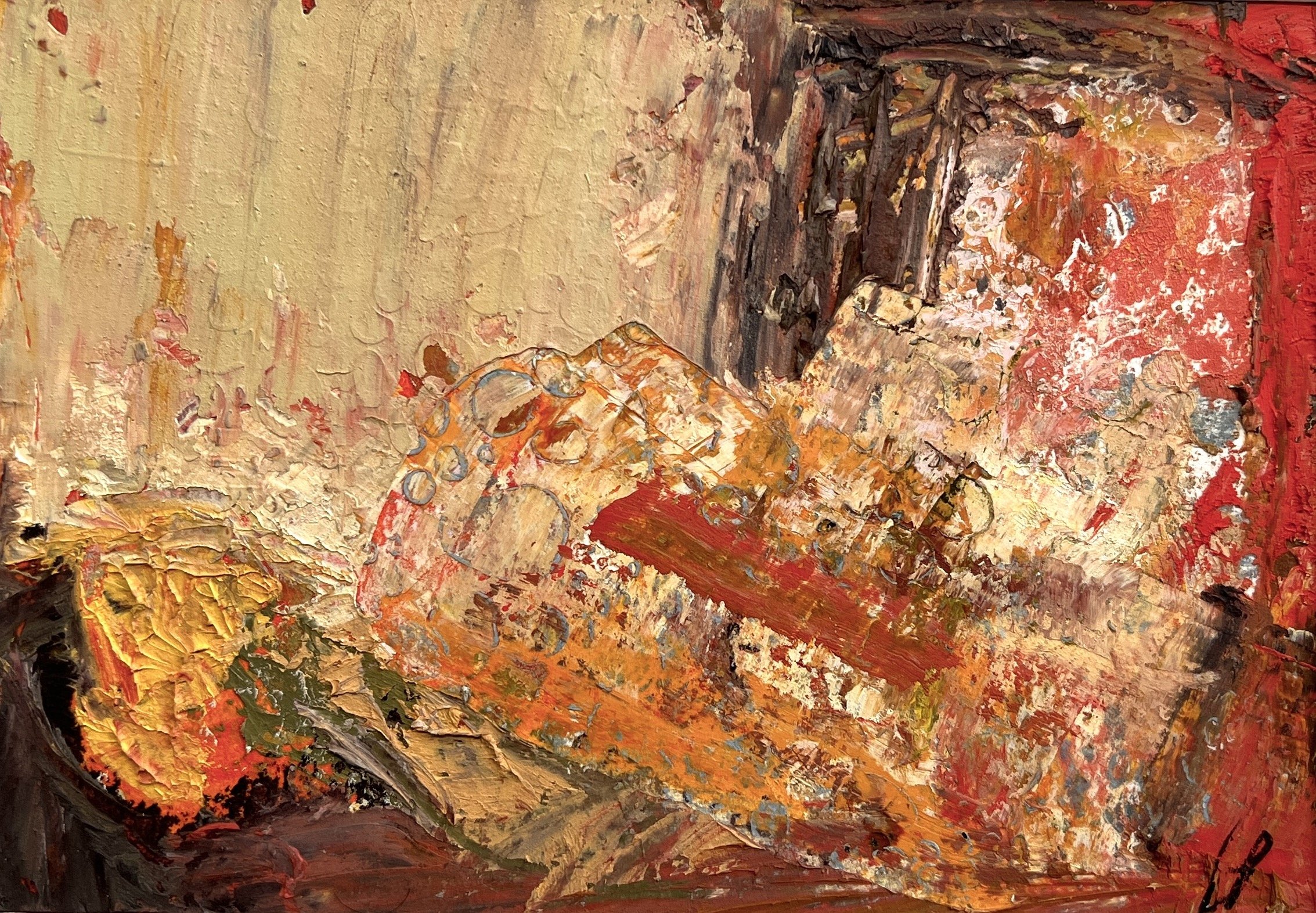Interviews
September 17, 2023
Lisa Pressman’s paintings are explorations of the human condition, with all its triumphs, frailties, and baggage. Her experimental use of materials is visually arresting and seemingly effortless, as she applies layers of translucent color and texture to achieve a rich, luminous surface. Pressman’s mastery over her medium is restrained rather than ostentatious; her paintings radiate with a golden light that is subtle yet seductive. She layers her paintings with encaustic, acrylic, and a variety of mediums and grounds, then digs into them with razor blades and clay tools, as if excavating our deepest emotions. The work is burnt with incense, sewn with suture-like stitches, and covered with a cryptic text that reads as an excised variant of our Roman alphabet. These hieroglyphs are composed of fragmented fonts that are vaguely familiar, but it’s no use trying to decipher them, as their meaning is impenetrable. It’s unclear what Pressman is trying to tell us, or if she knows herself. She appears to be channeling messages in a tongue that bypasses the intellect and speaks directly to the heart. Pressman is fluent in the language of grief, having experienced tremendous loss in her life. Her work is emotionally intense, laden with the acute joys and sorrows that can only be accessed through profound suffering. She shares her journey with a deep generosity of spirit, and we want to travel with her, knowing that on some level it’s our journey as well. Pressman’s work has a ritualized aspect, and we sense that in her process – paint, stitch, burn, repeat – she’s working something out on a transpersonal level. Her paintings have a rhythm, language, and function that remain an enigma, but through them we recognize that our own suffering, past and future, is neither solitary nor in vain. Indeed, in the extremities of our human experience, we all speak the same language.
MH: Your paintings are comprised of many layers, and there are passages where the material becomes very dense. How do you approach your work, and is process important to your practice?
LP: Process is extremely important. The process is about building the history of the piece, of what goes on and what covers up, of what conceals and what reveals, and this applies to anything I’m working on. Process is especially important now as I’m burning, smoking, and stitching the material, and even with the paint, where I’m layering in color, scraping into the surface, and so forth.
MH: The building up of layers, and then scraping into them, feels like an excavation of sorts. Are you searching for something? Is it a formal inquiry, or does it feel more metaphorical? Possibly both?
LP: Yes, absolutely both. Sometimes I’m searching for the magic moment that might be underneath, formally speaking, and with the oil paintings I’m searching for an image or something to reveal itself. I keep digging and digging until I find something that I can work with, a shape or a quality of light, that kind of thing.
MH: At this point in your career as an artist, do you feel confident that you’ll find it?
LP: If you’d asked me a year ago, I’d say absolutely! At the moment I’m having some doubt around it, but I definitely feel confident in my investigations, whether with the material or image. It’s an ongoing process, and the questioning is part of it.
MH: So it’s not always a given that you’ll come up with a good piece?
LP: It’s not always a given. Except that I’m very persistent, and I have no problem painting over something. My motto is when in doubt, paint it white (haha). I rarely throw a piece out, and I have piles and piles of work, so I don’t feel like anything is too precious.
MH: Your studio practice also consists of burning, sewing, melting, and smudging with incense. In addition to achieving a wide variety of marks on your surfaces, this starts to sound like a ritualized process. Do you ever approach your work as ritual?
LP: I never did until after my son Sam passed away in 2019. Now I feel connected to the idea of ritual, incense, burning the paper, rolling the ashes – it captivates me. I taught a class with my working partner Susan Stover on Meditative Practices in Contemporary Art, where we looked at a lot of work that has to do with burning, sewing, repetitive text – practices that relate to ritual. It inspired me to approach my work differently, not just as a formal painter. Like today I was in my studio burning incense, and the embers fell on my paper and burned holes in it, which was very satisfying.
MH: What’s the difference between process-oriented work and ritual-based work? Do you make a distinction between the two, or does it all run together?
LP: I never had a connection to ritual until recently. I was connected to material and process and the way I painted, with a lot of repetitive mark making that felt contemplative. But in the past few years the specificity of the materials that I’m using has lent themselves to ritual.
MH: Does your stitching have a ritualized aspect? Or is it more meditative? In some of your pieces, it feels like you’re mindfully mending something, almost like a suture on a psychic wound. How do you think about the sewing and thread?
LP: Yes, it’s meditative, and there’s a mystery about it. I like the idea that the stitching moves in and out, in front and behind, and there’s that sense of suturing, of mending something intangible. I also like the idea of stitching as bringing disparate things together, and I use red thread that has symbolic associations. In Buddhism red is a sacred color, the color of the life force, and Jung talks about the red thread running through life. But primarily it’s an aesthetic choice; it just feels right for me, and it’s healing.
MH: Yes, you spoke of the healing properties of color. Would you talk about that?
LP: After my mother passed away, I was in the studio, and it was a dark, depressing day. I was working with encaustic, and I decided to try using color to make myself feel better. So I created this amazing yellow painting that totally was the opposite of how I felt inside, but looking at it evoked positive emotional changes. I was able to respond differently, and that’s something that I’ve been focusing on.
MH: Do you think about this when you choose your color palette?
LP: The new work has color, but it’s understated, maybe because I’m getting older and learning more about color all the time. I’ve always focused on is having the color look like its coming from within, so there’s a glow or a sense of light that emanates from the painting.
MH: Right, I see that in your work and it’s very mysterious. How do you get that effect?
LP: I start with a warm, transparent ground, then I layer opaque and transparent layers, both warm and cool, building up the surface so that when I scrape into it, I’ll be bringing back what’s underneath. So the warmth or “glow” comes from the first layers that I put down.
MH: You must have to plan ahead, like chess moves.
LP: I don’t really plan ahead but I have a way of building surface that works for me. But it’s just call and response. I generally know how the layers will respond, but I never really know what’s going to happen; there are always surprises. Teaching has helped me figure out what I’m doing. I like using a razor blade to dig into the surface, and I sometimes use a clay tool. I sometimes call myself a “visceral materialist” because I relate to materials in any form, and my process is deeply intuitive.
MH: The thing that first drew me to your work was your distinctive use of text. It’s intriguing how you use language, text, and letters while avoiding specificity of any kind. The marks seem familiar, but as we move in close to decipher them, we cannot penetrate their meaning. What’s your thinking behind this?
LP: I’ve been using text for a long time, and the writing was always unclear. After my son passed, the writing became even more obscure, as I didn’t particularly want to share my grief. I didn’t want to go into the truth of how I felt. I like the mystery, the idea of something; I can hint at what I’m feeling without having to tell everything in the work. There’s a connection between what I’m communicating with the text and what you see and feel.
MH: I love your spare use of text. The emotion, the deep sensitivity, it’s all there in the writing, but if it was literal, it would be too much. It creates its own language.
LP: Yes, to me it looks more like mark making, and I like that. The other thing I’ve done is to write in smoke, and I also add full letters or commas in the Letraset typefaces, which are recognizable.
MH: I’m also intrigued by your process of applying text to your paintings, which creates an enigmatic calligraphy that’s just one step removed from our English language, and therefore recognizable, but it’s veiled and we cannot access it. You seem to want us to try to penetrate its meaning.
LP: I think of it as a beacon. You may not be able to read it, but you identify with it as a human being.
MH: Do you think it’s possible that when people look at your paintings, on some deep level they know this language? Is it the language of grief?
LP: Probably. Someone was looking at one of my pieces once who didn’t know anything about my work, and she said to me, I’ve got to have this, it reminds me of my late mother. I’ve always wanted to have that kind of emotional response to my work, to touch someone on that level. I want to make art that makes people feel something.
MH: It sounds to me like it’s important for you to have a heart connection, rather than a conceptual connection.
LP: Absolutely. When I was a young artist and trying to figure out what kind of work I wanted to make, I saw the work of Eva Hesse, and I knew that was it. I wanted to make work that made people feel, as opposed to think or overthink. It’s about human connection. I mean, I know that concepts are supposed to be important in an artist’s work, but I’m more interested in the heart connection.
MH: I think most artists are. The cerebral approach is interesting to talk about at dinner parties and art openings, but underneath it all, the heart connection is what people really want.
LP: Yes, and a sense of recognition, like this is something I can relate to, even if it’s not specific. A person gets the sense of a work of art, and they relate to it from their own experience of life.
MH: Do you think that by making the text unreadable, you’re communicating more? It seems to me that language almost gets in the way when it comes to communicating the deeper issues of the heart.
LP: Absolutely. I have a series called After Words, which refers to this. At some point words get in the way, because they’re too defining; they can constrict and limit a deeper understanding.
MH: I suppose if you were to write literally what you’re thinking and feeling, it would be like a Hallmark card.
LP: It would be corny and unnecessary, and it would get in the way.
MH: But there’s also the argument that if you don’t give some insight into the work, will the viewer get it? Unless they’re really tuned in, they’re probably not going to. So how do you handle that?
LP: It doesn’t bother me. I think the viewers don’t need to know the story, but they can intuit that the thread, burning, and language suggest something else going on. Something is trying to be communicated. It doesn’t have to be grief, it can be from another planet, another world. Hopefully the work stands on its own without the story.
MH: In a sense the artist creates the work, then gets out of the way. Because as we all know, artists are prone to getting in their own way.
LP: I like to leave it open. You don’t have to tell the viewer everything. You can leave something out, and I think that’s the same with the text. There’s enough left out, but there’s enough there to give the viewer a glimpse.
MH: Right, and the other thing is that if you tell the viewer your story, then that becomes what the piece is about. They don’t have the opportunity to put their own narrative on it, which may be more interesting than yours. The artist has to back off and trust the viewer to have her own experience.
LP: My mother took me to the Met a lot when I was a kid, and I remember being drawn to the Chinese scrolls. I didn’t know what they said, but they spoke to me, even though I didn’t understand them. There was magic in them, a mystery.
MH: I know that you’ve suffered tremendous loss in your life and have had to deal with unimaginable pain. How has your studio practice helped you through this?
LP: It gets me out of my head, which goes back to the practice of doing and making as a means toward healing, mending. In theory, if you engage in a creative practice, then perhaps the healing happens on its own.
MH: Do you think that sewing helps with healing? Or any kind of repetitive activity like that?
LP: I don’t know if it’s the sewing. If it was that, then I could just embroider. I think it’s the creative catharsis of material and making that’s healing. And my son was an incredible artist himself, so that’s a big connection for me.
MH: Of all the different materials that you use in your work – color, language, sewing, burning – is there one that you feel most drawn to, or is it all of a piece?
LP: It depends on whatever I’m working on. I do these limited palette paintings that are so immediate, and they’re captivating for me because they’re the opposite of all this other stuff that I’m doing. Today I was using incense and burning and moving around like a crazy person, and I’ve also been experimenting with acrylic. I’m really excited about my explorations with color. It’s kind of magical.
MH: What’s the best part about being an artist?
LP: I like the investigative quality, what happens if I do this or try that, and then I appreciate the surprises that happen along the way. I learn a lot about my own life from how I work in my studio. Being involved in the process and working things out is a metaphor for life. And then there’s the freedom. It’s the only place where you can do whatever you want – it’s absolute freedom.
www.lisapressman.net
To learn more about Lisa Pressman’s teaching courses and C2C Art Projects with Susan Stover, click here.
IMAGE LIST
1. Messages I, 2020, ink, Letraset on paper, 12 x 9 in.
2. What Remains, 2023, oil, paper, thread, smoke, wax, Letraset on panel, 48 x 36 in.
3. What Remains, detail
4. What Remains, detail
5. After Words 13, 2023, smoke, Letraset on paper, 12 x 9 in.
6. After Words 14, 2023, smoke, Letraset on paper, 12 x 9 in.
7. The Beginning, 2023 oil, ink, Letraset on paper, 8 x 8 in.
8. Creating Language, 2023, ink Letraset on paper, 8 x 8 in.
9. After Words 5, 2022, oil, ink, Letraset, burns on panel, 6 x 4 in.
10. The Letter, 2022, oil, thread, ink, smoke, Letraset on handmade paper, 17.5 x 15 in.
11. Letter 3, 2022, oil, ink, smoke, Letraset on board, 12 x 10 in.
12. We Are Here, 2023, ink, smoke, wax, Letraset on board, 12 x 10 in.
13. Manuscript 2, 2022, oil, thread, smoke, ink on handmade paper, 17.5 x 15 in.
14. Manuscript 1, 2022, oil, thread, smoke, ink on handmade paper, 17.5 x 15 in.
15. In the Space, 2023, smoke, thread, watercolor, Letraset on paper, 8 x 8 in.
16. What Happens After, 2019, encaustic, 12 x 12 in.
17. Excavating Light, 2019, oil and wax on panel, 10 x 10 in.
18. Things That Were Never Said, 2021, encaustic, 30 x 30 in.
19. Limited Palette 1, 2023, oil on paper, 5 x 7 in.
20. Limited Palette 2, 2023, oil on paper, 5 x 7 in.
21, 22. The artist in her studio.
 Other Interviews:
Other Interviews:
MacInnis, Stephen, Have you met Lisa Pressman, Painters Progress, July 3, 2013
Brennan, Valerie, A behind the scenes approach to contemporary painting Studio Critical, Jan 28, 2013
Seed, John Lisa Pressman: Passing Through at Causey, Huffington Post, Nov 12, 2015
